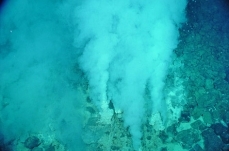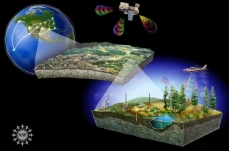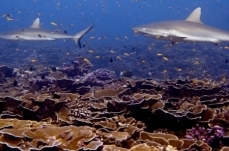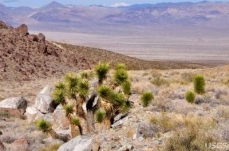Environmental Indicators (main)
Environmental Indicators
In the widest sense, an indicator is a sign or a signal that can convey a message, The message conveyed may be simple or it may be complex. Indicators provide us with information on things, situations, activities, processes or phenomena that exist or that are occurring in our surroundings. According to McQueen and Noack[1], indicators are defined as “. . .measures that summarize information relevant to a particular situation, or a reasonable proxy for such a measure”.
Examples of indicators include:
- A directional signal of an automobile: It can indicate when and how an automobile will turn.
- The temperature reading on a thermometer:
- It can indicate indoor or outdoor comfort levels;
- It can indicate the likelihood of disease-related conditions.
Indicators can have their greatest value as proxies or substitutes for measuring conditions that are so complex that currently there are limited possibilities for direct measurement. For example, data from reconnaissance orbiter photographs—and such other indirect measurements as exploration rover-based spectrographs taken recently—of the surface of Mars indicate the likely past presence of water.
Also, indicators may be aggregated or grouped (with or without weighting) into what are referred to as either indices or indexes. Often, these indices or indexes are useful in conveying complicated information in a simple, straightforward manner. A good example of an index is The American Consumer Satisfaction Index: a conglomeration—or aggregation—of econometric data collected through interviews. It is used to indicate how comfortable consumers say they feel about their economic condition—and that of the U.S. economy.
Indicators are developed and used predominantly to highlight the workings or the performance—or the lack thereof—of a system. The system may be biological, physical, chemical, economic or social. These indicators can tell us something about a system's status—and over time, about a system's operating trends. Indicators are used worldwide by scientists, governments, private-sector entities, and organizations and individuals in the general public. Their use of indicators boils down to having a “need-to-know”.
Again, indicators are as varied as the types of systems they monitor. However, according to the Website of Sustainable Measures, a provider of sustainability training services, there are certain characteristics that useful, effective, defensible and believable indicators have in common:
- Effective indicators are relevant; they show you something about the system that you need to know.
- Effective indicators are easy to understand, even by people who are not experts.
- Effective indicators are reliable; you can trust the information that the indicator is providing.
- Effective indicators are based on accessible data; the information is available or can be gathered while there is still time to act.
-
 Featured Article
Featured Article  Geophony, Biophony, and AnthrophonyWhat do these words mean? Biophony is the melodic sound created by such organisms as frogs and birds; geophony, the composition of non-biological sounds like wind, rain and... More »
Geophony, Biophony, and AnthrophonyWhat do these words mean? Biophony is the melodic sound created by such organisms as frogs and birds; geophony, the composition of non-biological sounds like wind, rain and... More »
-
 Featured Article
Featured Article  Sonoran Bumblebee (Environmental Indicators)Bombus sonorus, the Sonoran Bumblebee The Sonoran bumblebee, Bombus sonorus, is a large and colorful native bee of the Sonoran desert and much of the western United States.... More »
Sonoran Bumblebee (Environmental Indicators)Bombus sonorus, the Sonoran Bumblebee The Sonoran bumblebee, Bombus sonorus, is a large and colorful native bee of the Sonoran desert and much of the western United States.... More »
-
 Featured Article
Featured Article  Perdita minima (Environmental Indicators)Perdita minima "World’s Smallest Bee" Native bees come in all shapes and sizes. Many gardeners are familiar with the large black and yellow... More »
Perdita minima (Environmental Indicators)Perdita minima "World’s Smallest Bee" Native bees come in all shapes and sizes. Many gardeners are familiar with the large black and yellow... More »
-
 Featured Article
Featured Article  Extremophile (Environmental Indicators)An extremophile is an organism adapted to unusual limits of one or more abiotic factors in the environment. Some of the extreme conditions are temperature, pH, high salinity,... More »
Extremophile (Environmental Indicators)An extremophile is an organism adapted to unusual limits of one or more abiotic factors in the environment. Some of the extreme conditions are temperature, pH, high salinity,... More »
-
 Featured Article
Featured Article  Changes in the Landscape of Arctic Traditional...This article, written by Tim Lougheed*, appeared first in Environmental Health Perspectives—the peer-reviewed, open access journal of the National Institute of... More »
Changes in the Landscape of Arctic Traditional...This article, written by Tim Lougheed*, appeared first in Environmental Health Perspectives—the peer-reviewed, open access journal of the National Institute of... More »
-
 Featured Article
Featured Article  National Ecological Observatory Network:...NSF Awards Construction Funding to National Ecological Observatory Network Long-awaited, continent-wide network of environmental observing sites gets off the... More »
National Ecological Observatory Network:...NSF Awards Construction Funding to National Ecological Observatory Network Long-awaited, continent-wide network of environmental observing sites gets off the... More »
-
 Featured News Article
Featured News Article  Loss of Large Predators: Ecosystem HarmLoss of Large Predators Caused Widespread Disruption of Ecosystems Decline of "top consumers" may be humans' most pervasive influence on natural world The decline... More »
Loss of Large Predators: Ecosystem HarmLoss of Large Predators Caused Widespread Disruption of Ecosystems Decline of "top consumers" may be humans' most pervasive influence on natural world The decline... More »
-
 Featured News Article
Featured News Article  Lionfish Spread UnprecedentedInvasive Marine Fish May Stress Reefs The rapid spread of lionfishes along the U.S. eastern seaboard, Gulf of Mexico, and Caribbean is the first documented case of a... More »
Lionfish Spread UnprecedentedInvasive Marine Fish May Stress Reefs The rapid spread of lionfishes along the U.S. eastern seaboard, Gulf of Mexico, and Caribbean is the first documented case of a... More »
-
 Featured News Article
Featured News Article  Joshua Trees and Climate ChangeUncertain Future for Joshua Trees Projected with Climate Change Temperature increases resulting from climate change in the Southwest will likely eliminate Joshua trees from 90... More »
Joshua Trees and Climate ChangeUncertain Future for Joshua Trees Projected with Climate Change Temperature increases resulting from climate change in the Southwest will likely eliminate Joshua trees from 90... More »
 Sustainable Society Index Last Updated on 2014-07-31 13:15:01 When we were looking for a suitable yardstick to measure the level of sustainability of a country a suitable instrument could not be found. Although the main existing indexes were examined we had to conclude that none of them seem to fit our needs completely. The main shortcomings are a limited definition of sustainability, a lack of transparency or high complexity and an absence of regular updates. For this reason, a new index – the Sustainable Society Index (SSI) – has been developed. The SSI integrates the most important aspects of sustainability and quality of life of a national society in a simple and transparent way. Consisting of only 22 indicators, grouped into 5 categories, it is based upon the definition of the Brundtland Commission, extended to the Brundtland+ definition by explicitly including the social aspects of human life. Using data from public sources,... More »
Sustainable Society Index Last Updated on 2014-07-31 13:15:01 When we were looking for a suitable yardstick to measure the level of sustainability of a country a suitable instrument could not be found. Although the main existing indexes were examined we had to conclude that none of them seem to fit our needs completely. The main shortcomings are a limited definition of sustainability, a lack of transparency or high complexity and an absence of regular updates. For this reason, a new index – the Sustainable Society Index (SSI) – has been developed. The SSI integrates the most important aspects of sustainability and quality of life of a national society in a simple and transparent way. Consisting of only 22 indicators, grouped into 5 categories, it is based upon the definition of the Brundtland Commission, extended to the Brundtland+ definition by explicitly including the social aspects of human life. Using data from public sources,... More »  Improving access to and use of earth science data Last Updated on 2013-10-22 23:34:26 USGS Helps Debut New Technology to Improve Access and Use of Earth Science Data Researchers investigating global issues now have an easy method for finding and using earth science data through a new technology developed by the Data Observation Network for Earth, or DataONE. Understanding broad and complex environmental issues, for example climate change, increasingly relies on the discovery and analysis of massive datasets. But the amount of collected data—from historical field notes to real-time satellite data—means that researchers are now faced with an onslaught of options to locate and integrate information relevant to the issue at hand. DataONE, a ten-institution team with several hundred Investigators, including researchers from the United States Geological Survey (USGS), is addressing this data dilemma with a number of cyberinfrastructure and... More »
Improving access to and use of earth science data Last Updated on 2013-10-22 23:34:26 USGS Helps Debut New Technology to Improve Access and Use of Earth Science Data Researchers investigating global issues now have an easy method for finding and using earth science data through a new technology developed by the Data Observation Network for Earth, or DataONE. Understanding broad and complex environmental issues, for example climate change, increasingly relies on the discovery and analysis of massive datasets. But the amount of collected data—from historical field notes to real-time satellite data—means that researchers are now faced with an onslaught of options to locate and integrate information relevant to the issue at hand. DataONE, a ten-institution team with several hundred Investigators, including researchers from the United States Geological Survey (USGS), is addressing this data dilemma with a number of cyberinfrastructure and... More »  Indicators of sustainable development Last Updated on 2013-10-22 00:10:20 Indicators attempt to convey a broader image than the underlying statistics would suggest. For instance, the average life expectancy of an infant is usually taken to indicate the public health of a population. The purpose of selecting one or more indicators for describing a broader subject is to reduce information overload for data users. The strength and weakness of indicators lie in their selection, which facilitates decision-making but also opens the door to data manipulation. The alternative is aggregation of statistics and indicators into compound indices. Aggregation methods include the calculation of weighted or unweighted averages, summation in accounts and balances and mathematical reduction of correlated indicators by factor analysis. Indicator lists of varying length seek to capture the different – economic, environmental, social and institutional –... More »
Indicators of sustainable development Last Updated on 2013-10-22 00:10:20 Indicators attempt to convey a broader image than the underlying statistics would suggest. For instance, the average life expectancy of an infant is usually taken to indicate the public health of a population. The purpose of selecting one or more indicators for describing a broader subject is to reduce information overload for data users. The strength and weakness of indicators lie in their selection, which facilitates decision-making but also opens the door to data manipulation. The alternative is aggregation of statistics and indicators into compound indices. Aggregation methods include the calculation of weighted or unweighted averages, summation in accounts and balances and mathematical reduction of correlated indicators by factor analysis. Indicator lists of varying length seek to capture the different – economic, environmental, social and institutional –... More »  Changes in the Landscape of Arctic Traditional Food Last Updated on 2013-10-21 23:45:06 This article, written by Tim Lougheed*, appeared first in Environmental Health Perspectives—the peer-reviewed, open access journal of the National Institute of Environmental Health Sciences. The article is a verbatim version of the original and is not available for edits or additions by Encyclopedia of Earth editors or authors. Companion articles on the same topic that are editable may exist within the Encyclopedia of Earth. The Changing Landscape of Arctic Traditional Food The earliest European explorers seeking a northwest passage to Asia did not know what to make of the indigenous inhabitants they encountered in what is now Canada. In the 1500s, Martin Frobisher thought they were Asians and took a number as slaves; none survived more than a few weeks in captivity. Later adventurers acquired a profound respect for the knowledge that had enabled Inuit (“the... More »
Changes in the Landscape of Arctic Traditional Food Last Updated on 2013-10-21 23:45:06 This article, written by Tim Lougheed*, appeared first in Environmental Health Perspectives—the peer-reviewed, open access journal of the National Institute of Environmental Health Sciences. The article is a verbatim version of the original and is not available for edits or additions by Encyclopedia of Earth editors or authors. Companion articles on the same topic that are editable may exist within the Encyclopedia of Earth. The Changing Landscape of Arctic Traditional Food The earliest European explorers seeking a northwest passage to Asia did not know what to make of the indigenous inhabitants they encountered in what is now Canada. In the 1500s, Martin Frobisher thought they were Asians and took a number as slaves; none survived more than a few weeks in captivity. Later adventurers acquired a profound respect for the knowledge that had enabled Inuit (“the... More »  Which fish should I eat? Last Updated on 2013-09-03 12:09:16 Despite the relative lack of information integrating the health, ecological, and economic impacts of different fish dietary choices, clear and simple guidance is needed to effect wise consumption of wild and domesticated fisheries resources. This Review article, written by Emily Oken, Anna L. Choi, Margaret R. Karagas, Koenraad Mariën, Christoph M. Rheinberger, Rita Schoeny, Elsie Sunderland, and Susan Korrick* appeared first in Environmental Health Perspectives—the peer-reviewed, open access journal of the National Institute of Environmental Health Sciences. The article is a verbatim version of the original and is not available for edits or additions by Encyclopedia of Earth editors or authors. Companion articles on the same topic that are editable may exist within the Encyclopedia of Earth. Which Fish Should I Eat? Perspectives Influencing Fish Consumption... More »
Which fish should I eat? Last Updated on 2013-09-03 12:09:16 Despite the relative lack of information integrating the health, ecological, and economic impacts of different fish dietary choices, clear and simple guidance is needed to effect wise consumption of wild and domesticated fisheries resources. This Review article, written by Emily Oken, Anna L. Choi, Margaret R. Karagas, Koenraad Mariën, Christoph M. Rheinberger, Rita Schoeny, Elsie Sunderland, and Susan Korrick* appeared first in Environmental Health Perspectives—the peer-reviewed, open access journal of the National Institute of Environmental Health Sciences. The article is a verbatim version of the original and is not available for edits or additions by Encyclopedia of Earth editors or authors. Companion articles on the same topic that are editable may exist within the Encyclopedia of Earth. Which Fish Should I Eat? Perspectives Influencing Fish Consumption... More »